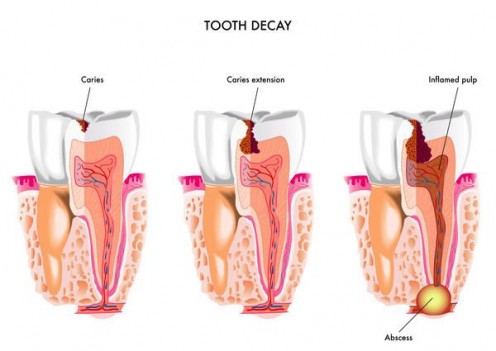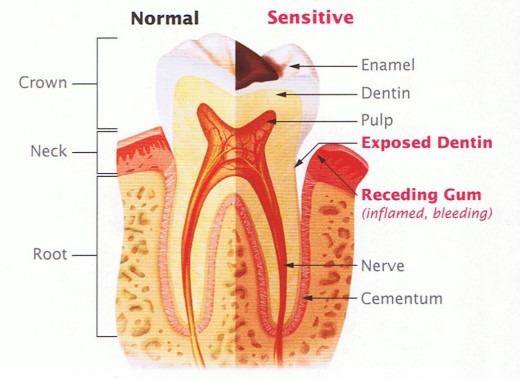Tooth Hypersensitivity - A Universal Oral Health Problem

Sensitivity - A Nuisance considered by Most Patients
We all know that the tooth consists of 3 parts-
1) Enamel - which is the outer layer covering the entire crown and Cementum which covers the root portion.
2) Dentin - the layer which is below the enamel and cementum and is made up of dentinal tubules. These tubules may contain nerve extensions from the pulp and minute amounts of water.
3) Pulp - an area surrounded by dentin on all sides except at the root tip. It is rich in blood vessels, cells, and nerves.
Sensitivity is caused when one feels pain on drinking or eating hot or cold food. More often caused due to irregularities on the tooth surface leading to exposure of dentinal tubules. Sometimes one diagnosis may not be enough to explain the cause of sensitivity.

Age of Occurence
It is most commonly seen in individuals at a range from 30- 50 years of age.
Causes of Sensitivity
There are several factors that cause sensitivity of teeth:
1) Wearing of teeth
2) Dental caries
3) Enamel- cementum gap
4) Gingival diseases (Gum diseases)
5) Periodontal diseases
6) Chemical agents
7) Cracked tooth
8) Fractured restoration or fractured tooth
1 ) Wearing Off of Teeth
Wearing of teeth are divided into 2 types:
a) Physical wear - Abrasion, attrition, and abfraction
Abrasion is the non-carious wearing of teeth caused by mechanical factors other than mastication or chewing. The mechanical factors include excessive strength while brushing and incorrect brushing technique.
Attrition is caused due to the tooth to tooth contact resulting in the eventual reduction of incisal or occlusal part of the teeth. It is of 2 types: Physiological and Pathological.
It is a physiological process when it is caused as age progresses. In other words, this particular wearing of teeth is a part of aging.
It is pathological when one grinds and clenches their teeth mostly while sleeping. This is caused due to stress or anxiety. The patient may not even be aware of this and wakes up the next morning with pain in the jaw muscles.
Abfraction is the mechanical loss of tooth structure along the gingival / gum line.
b) Chemical wear - Erosion
Erosion otherwise known as acid erosion is an irreversible loss of tooth structure caused by acidic agents like excessive use of beverages and frequent vomiting. It commonly occurs on the lingual aspect (tooth surface facing the tongue) of the teeth.

Dental Caries
Dental Caries is the irreversible decaying of teeth caused due to the breakdown of tooth structure by acids produced by bacteria. Commonly found bacteria is Streptococcus Mutans, Streptococcus Salivarius, some strains of Actinomyces, Lactobacillus and many others with most common being Streptococcus Mutans.
Dental Caries is initiated when the pH level goes below 5 i.e. acidic pH. The color ranges from chalky white or yellow to brown or black. The presence of caries can cause sensitivity and if not treated can progress and result in infection of pulp and pain.
There are different classes of caries, also known as the G.V.Black's classification:
Class 1 - occurs on occlusal surface involving pits and fissures of molars and premolars, lingual surfaces of maxillary/upper incisors.
Class 2 - occurs on proximal aspect of posteriors i.e. molars and premolars.
Class 3 - involves the proximal surface of the anterior/front teeth not involving the incisal angle.
Class 4 - involves the proximal and incisal angle of the anterior teeth i.e. incisors and canines.
Class 5 - occurs on the cervical aspect or neck portion of the teeth.
Class 6 - occurs on the incisal edges of the anterior/front teeth and cusp tips of the posterior/back teeth.

Enamel - Cementum Gap
The tooth consists of the crown and the root. The crown is covered by the enamel and the root is covered by the cementum. Between the two, there is a joint or the meeting point or margin called the Cementoenamel Junction (CEJ). If this meeting point is not properly developed or if the enamel and the cementum do not meet tip to tip, it exposes the underlying dentin and results in sensitivity.
Again classified into 3 :
1) Butt Junction - Joint where the enamel and cementum meet each other end-end.
2) Gap Junction - Enamel and Cementum does not meet. Instead, a gap persists between the two causing exposure of dentinal layer.
3) Overlapping Junction - Either the cementum overlaps the enamel (60% of the cases) or the enamel overlaps the cementum (1- 2 % of cases ).

Gingival Diseases
Gum diseases ranging from mild to severe can cause sensitivity. While mild inflammations may not be problematic, severe ones are a cause for concern. In such cases, it is important to visit the dentist and clarify the cause of inflammation. Reasons involved can be the presence of food stuck between the teeth close to the gums, some medications and also due to bacterial or viral infections.
Pregnant women also develop inflamed gums and sensitivity and are caused mainly due to pregnancy hormones. Similarly it is also a pre-menstrual symptom which calms down once the cycle begins.
Vitamin deficiency like deficiency of Vitamin C can cause Scurvy. Due to this, inflammation of gums, sensitivity and later leading to the fallout of teeth is evident. Therefore Vitamin C is vital for the collagen formation of the gums.

Periodontal Diseases
Untreated gingival diseases can cause detachment of periodontal ligament ( ligament connecting the teeth to the bone/alveolar crest) leading to periodontal diseases. This rapidly leads to infection causing sensitivity and recession of gums from the gum line. It further goes on to development spacing or shifting and mobility of the teeth.
Chemical Agents
Chemical agents such as bleaching cause sensitivity. Use of bleaching agents is becoming a trend now in our modern world. Almost all the bleaching products contain an agent called hydrogen peroxide, the culprit responsible for gum irritation and sensitivity. Further research confirms that these agents also roughens the tooth surface, softens and increases demineralisation potential. Once bleaching application is stopped, sensitivity ceases.
Cracked Tooth Syndrome (CTS)
A cracked tooth or split tooth syndrome is a hairline fracture or the incomplete cracking of the tooth but the cracked part has not yet broken off. The crack in the tooth leaches food particles and bacteria into the tooth structure closer to the dental - pulp zone ultimately leading to sensitivity and as time progresses causes pain and removal of pulp.
CTS can be easily missed while viewing the X-ray film.

Fractured Restoration and Fractured Tooth
A fractured tooth or restoration can expose the Dentinal layer leaving the dental tubules at the mercy of the bacterial agents in the mouth. Fractured restorations should be immediately removed and replaced with new ones.


Treatment provided for Sensitivity
There are various treatment options provided for sensitivity.
1) In the case of incorrect brushing technique. It is important that the brushing method is corrected. This avoids the early wearing off of the teeth.
2) Use of soft-bristled toothbrush.
3) Any dental caries should be restored as soon as possible. Longer the wait, more the amount of removal of affected tooth structure.
4) Consult a dentist where gingival and periodontal diseases are concerned.
5) Use of bleaching agents should be reduced or ceased completely if sensitivity becomes severe.
6) Desensitizing toothpaste containing potassium nitrate or stannous fluoride are available like Sensodyne sensitive toothpaste, Colgate sensitive toothpaste. Reduction in sensitivity is usually seen after 1-2 weeks of application.
7) Avoid highly acidic food and less use of beverages.
How often does Teeth Sensitivity affect your daily work routine?
This content is for informational purposes only and does not substitute for formal and individualized diagnosis, prognosis, treatment, prescription, and/or dietary advice from a licensed medical professional. Do not stop or alter your current course of treatment. If pregnant or nursing, consult with a qualified provider on an individual basis. Seek immediate help if you are experiencing a medical emergency.
© 2019 Stephy Varghese Thazhone








